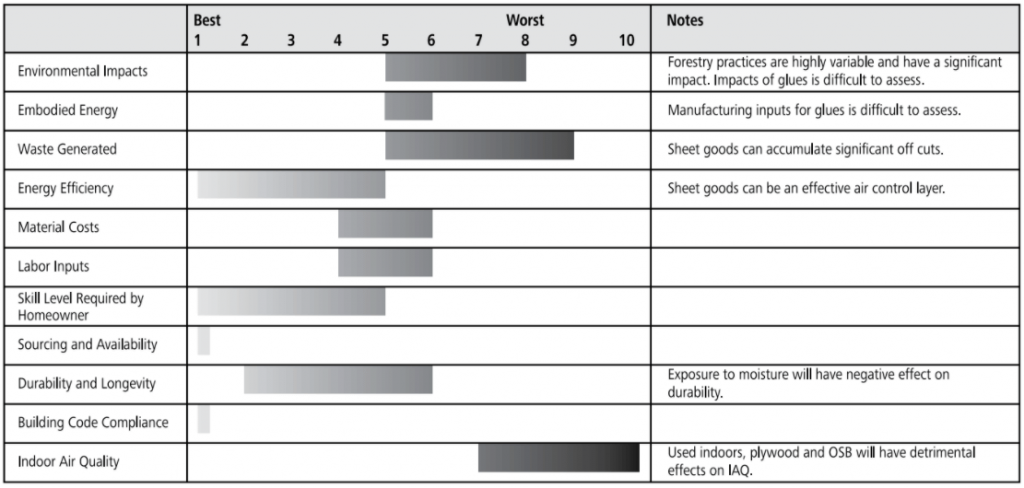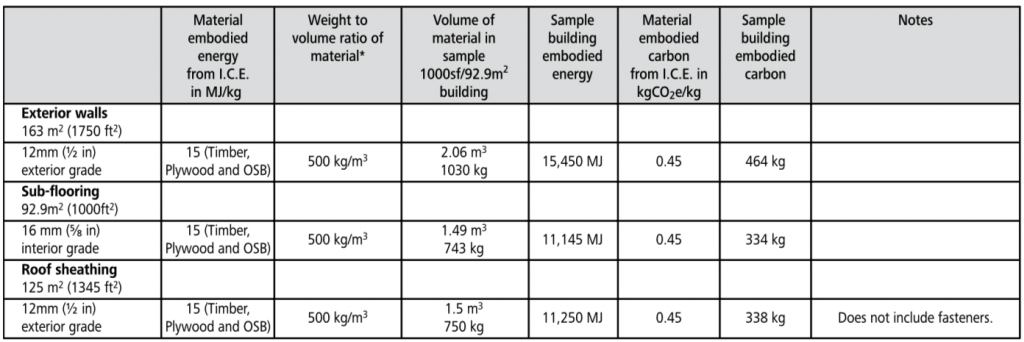plywood & Osb
cladding: MATERIALS ENCYcLOPEDIA
Applications for this system
Structural wall sheathing
Basic materials
Wood veneer (plywood)
Wood flakes (OSB)
Adhesive
Ratings Chart for Plywood and OSB sheathing

The ratings chart shows comparative performance in each criteria category. Click on the tabs below for detailed analysis of each criteria.
- HOW THE SYSTEM WORKS
- ENVIRONMENTAL IMPACTS
- WASTE
- EMBODIED CARBON
- ENERGY EFFICIENCY
- MATERIAL COSTS
- LABOUR INPUT
- SKILL LEVEL REQUIRED
- SOURCING & AVAILABILITY
- DURABILITY
- CODE COMPLIANCE
- INDOOR AIR QUALITY
- RESOURCES
- FUTURE DEVELOPMENT
Plywood/OSB sheathing System
Plywood
Logs are felled, debarked and soaked in hot water. Veneer sheets are peeled from the soaked logs and glued together as plies, with the grain of each ply aligned perpendicular to the adjacent ply. The plies are pressed together with heat. Each ply is typically 3 mm or 1/8 inch thick and sheets for construction are made in 3-, 4-, 5- and 6-ply thicknesses.
OSB
Oriented strand board uses flakes of wood peeled from logs that would not have been suitable for other purposes. The flakes are dried, impregnated with glue, oriented in cross-directional “mats” and then pressed under high heat and pressure to form panels.
Both materials are available in 4×8 ft sheets. In most applications, the sheets are nailed to the studs, sills and headers of a wood frame wall or to roof rafters. Joints between panels are aligned on framing members and blocking. A nailing pattern is specified around the edge and in the field of each panel.
Environmental Impact Rating
Harvesting — Moderate to High
Logs for sheet materials mainly come from large forestry operations, which can have impacts including habitat destruction, deforestation, soil erosion and silting and contamination of surface water.
Manufacturing — Moderate to High
Making sheet materials is a multi-stage process that requires relatively high-energy inputs, in particular the heating of water baths for logs and the heat required when pressing materials into sheets. In plywood manufacturing, between 25%–50% of each log is not usable for creating plies. This used to result in a lot of waste, but much of this material is now used in making OSB.
The glues used for these products are petrochemical based and impacts from their manufacture and use include habitat destruction and air and water pollution.
Transportation — Low to High
Sample building uses 1,030 kg of plywood or OSB sheathing for the exterior walls:
1.55 MJ per km by 15 ton truck
1 MJ per km by 35 ton truck
0.25 MJ per km by rail
The vast majority of sheet wood products are manufactured on the midwest coast of North America and shipped across the continent.
Installation — Low
Waste: moderate to high
Compostable — None.
Recyclable — Metal fasteners. Quantities are small.
Landfill — Plywood and OSB offcuts. Quantities can range from small to large, depending on the number of offcuts.
Chart of Embodied energy & carbon
Energy Efficiency
Wood sheet materials can contribute to an airtight building enclosure, especially when gasketed, caulked or taped to the framing at all joints. The materials do not directly contribute to thermal performance.
Material costs: moderate
Sheet materials are produced on a scale that makes them a moderately priced option. Competition between producers and retailers for these high-demand products has created pricing that is not reflective of the relatively high embodied energy of the materials.
Labour Input: moderate
Sheets cover a large amount of square footage and are sized to correspond to standard framing spacing. When plans make good use of this sizing, labor inputs can be low. The cutting of sheet materials can be time-consuming, so the more custom cuts required the higher the labor input.
Health Warning
Sawdust contains toxins from glues; wear breathing protection when cutting.
Skill level required for homeowners
Preparation of substrate — Easy to Moderate
Sheet wood applies to the studs of a frame wall. A homeowner capable of accurate framing work will create a good backing for sheets.
Installation of sheathing — Moderate
Large sheets take some practice to handle, cut and install. A homeowner capable of accurate framing work will also be able to apply sheathing successfully.
Finishing of sheathing — Easy
There is typically no finishing applied to sheet wood products. In rare cases where sheet wood is the final finish, surface treatment products are rolled or brushed onto the surface.
Sourcing & availability: Easy
Sheet wood is widely available through building supply outlets.
Durability: moderate
Sheet wood is reasonably durable when kept dry. Though much work has gone into formulating glues that are water-resistant, the surface area of the plies and wood flakes result in a lot of swelling when the products get wet and the swell-shrink cycle can destroy the bond of the glue. OSB in particular is susceptible to degradation from wetting.
The most likely moisture damage to these products comes from condensation on the backside of the sheets due to air leakage from the inside of the walls. As these materials are not very permeable, moisture can accumulate and damage the sheets. This damage won’t be seen until the materials are close to or beyond the point of failure because the sheet wood is usually hidden behind cladding.
Code compliance
Sheet wood is an acceptable solution in all jurisdictions.
Indoor air quality
Used on the exterior of the building, these materials will have no effect on IAQ. The glues used in these products are formaldehyde based and can off-gas significantly. They are not recommended for use in any interior applications, as they will have negative IAQ effects.
Resources for further research
Resources for further research
Bramwell, Martyn, editor. The International Book of Wood. New York: Simon and Schuster, 1976.
Duncan, S. Blackwell. The Complete Plywood Handbook. Blue Ridge Summit, PA: Tab Books, 1981.
Forest Products Laboratory. Wood Handbook: Wood as an Engineering Material. United States Department of Agriculture, 1987.
Future development
The growth of third-party certification programs makes it likely that more sustainably harvested sheet wood products will become available. Effort has gone into reducing the amount and type of formaldehyde used in glues, but all exterior-grade sheet wood still contains glues with toxic chemicals. Pressure for more environmentally friendly options is driving R&D developments that may result in more benign adhesives.
The ability to use substandard logs to make OSB means that these products are likely to continue to make up a large and growing portion of the market as the quantity of available high-quality trees continues to shrink. Nontoxic glues would make the use of OSB more environmentally suitable.
Tips for successful plywood/osb sheathing
1. If sheet material is to be used as sheathing, plan to make the best use of standard sheathing dimensions. Significant waste can accumulate if many custom cuts are required.
2. Sheet wood can be used as a primary air control layer if all joints are gasketed, caulked or taped appropriately. Typically, these products are used in conjunction with sheet-type barriers, but the barriers are not required if the sheathing itself has been sealed adequately.
3. Plywood and OSB are not very vapor-permeable. As they are usually applied on the exterior of a wall, this dictates the use of low-permeability materials on the interior, or the use of sheet-style vapor barriers.
4. Be sure to follow the nailing pattern recommended by codes and/or manufacturer’s instructions and use the specified type and length of nail.




